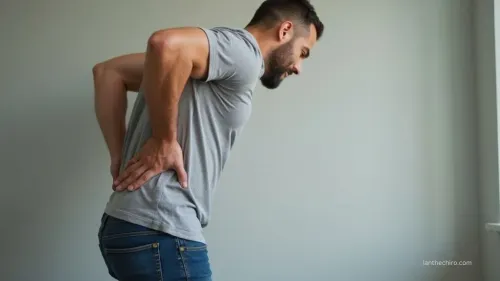Sprained Ankle Treatment: Why Rest Alone Fails (Chiropractic Rehab Tips)
Resting alone after a sprained ankle won’t rebuild strength or restore stability, you’ll stay weak and vulnerable to repeat injuries. Your ligaments and muscles need targeted exercise, not just time off, to heal properly.
Chiropractic rehab speeds recovery with gentle adjustments, soft tissue therapies, and essential strengthening drills. These steps boost blood flow, flush swelling, and train your ankle for balance and support.
Stick with expert guidance and discover exactly how to get your ankle strong for good.
What Actually Happens When You Sprain Your Ankle

When you sprain your ankle, the ligaments that support your joint stretch or tear, triggering immediate pain, swelling, and a sense of instability.
An ankle sprain sets off your body’s inflammatory response, causing increased blood flow and fluid to rush into the area. Swelling often appears quickly, sometimes forming noticeable soft tissue lumps within minutes.
These injuries disrupt your ankle’s normal structure, making it difficult to move or bear weight, and often affecting your balance.
If you don’t address the injury properly, the ligaments may heal in a weakened or misaligned position, increasing your risk for chronic instability and repeat injuries.
Understanding what’s happening inside your ankle helps you choose the right steps for effective recovery and long-term joint health.
Why Rest Alone Leads to Weak Recovery and Recurring Injury
Although taking it easy after a sprained ankle may seem like the safest route, relying on rest alone actually slows your recovery and puts you at risk for future problems. When you don’t engage in muscle activation or targeted exercises, your ankle muscles weaken and joints become stiff, making it harder to regain normal movement.
Prolonged rest alone can cause muscle atrophy, delay lymphatic drainage, and allow swelling to linger, all of which prolong healing. Without activating the muscles and ligaments, your ankle won’t rebuild the strength and stability needed to prevent another injury.
Research consistently shows that active rehabilitation, rather than rest alone, shortens recovery and reduces the risk of recurring sprains. To fully recover, you need more than just rest, you need to move.
How Chiropractic Rehab Speeds Up Healing and Stability

By incorporating chiropractic rehabilitation into your recovery plan, you give your ankle the best chance to heal quickly and regain full stability. Unlike passive rest, chiropractic care for an ankle injury actively supports the rehabilitation process by enhancing blood flow and lymphatic drainage, which speeds up tissue repair and reduces swelling.
Gentle adjustments realign your joint structures, restoring normal movement and preventing further compensatory injuries. Soft tissue therapies work in tandem to address muscle imbalances that rest alone can’t fix.
Chiropractors also prescribe targeted exercises that strengthen key stabilising muscles, increasing your ankle’s resilience and reducing the risk of re-injury. Evidence shows this approach markedly shortens recovery times and ensures long-term mobility, giving you a stronger, healthier ankle for the future.
Essential Rehab Exercises for a Stronger Ankle
Once your initial pain and swelling subside, it's essential to start gentle rehab exercises to regain ankle strength and flexibility. Begin with simple range-of-motion movements like ankle circles and dorsiflexion, which help restore flexibility and reduce stiffness.
As you progress, add strengthening exercises such as resistance band walks and calf raises. These moves target key muscles and improve ankle stability, reducing your risk of future injuries.
Balance drills, like single-leg stands on an uneven surface, boost proprioception and joint awareness. Always progress gradually from seated to standing exercises, to ensure safe tissue healing.
Preventing Repeat Ankle Sprains: What Actually Works Long-Term

Building ankle strength and flexibility through targeted rehab exercises lays a solid foundation, but preventing repeat sprains takes more.
Long-term success against ankle sprains relies on a holistic rehabilitation plan that addresses strength, balance, and proprioception. Evidence shows you’re far less likely to suffer another sprain if you consistently train your ankle’s supporting muscles and nervous system.
Challenge your balance with single-leg drills, and practice movements that mimic your daily activities or sports. Use resistance bands and stability tools to keep rehab progressive and effective.
Don’t skip joint mobility work, restored range of motion is key to functional stability. Remember, neglecting rehabilitation increases your risk of chronic instability and re-injury.
Stick to your plan, and you’ll safeguard your ankles for the long haul.
Frequently Asked Questions
Can Chiropractic Help With a Sprained Ankle?
Yes. Chiropractic care can support faster recovery from a sprained ankle by improving joint alignment, circulation, and mobility. It’s especially effective when combined with proper rest and a structured rehab plan.
How Do You Rehab a Badly Sprained Ankle?
Start with brief rest and controlled movement. Follow with range-of-motion work, gradual weight-bearing, balance drills, and strength training. Professional guidance helps avoid chronic issues and speeds up recovery.
Should a Sprained Ankle Be Rested?
Yes, but only at the start. Brief rest helps manage swelling and pain, but early movement and rehab exercises are key for faster healing and long-term stability..
What Is the Best Way to Rest a Sprained Ankle?
Use the R.I.C.E. method: rest briefly, ice it, compress the joint, and elevate the leg. Add light movement as soon as you can tolerate it, this helps prevent stiffness and speeds recovery.
Getting Your Ankle Back on Track, The Smarter Way to Heal
Don’t just rest, rebuild. Don’t just wait, take action. By combining rest with targeted chiropractic rehab, you’ll restore alignment, regain strength, and reduce your risk of future injuries.
Research shows that movement, guided exercises, and hands-on care help your ankle heal faster and more completely.
Trust the process, stay consistent, and be proactive with your recovery. Your ankle and your future self will thank you for going beyond rest and choosing a smarter path to healing.














